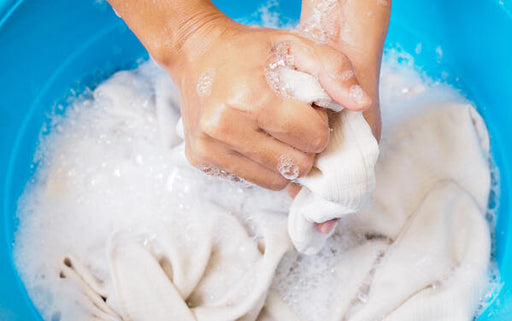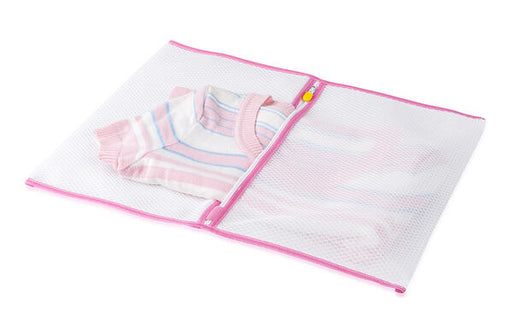What Clothes Can Be Dry Cleaned?

You have a secret, don’t you? One that you are probably hiding in your bedroom closet or laundry room. Don’t worry. We understand. All that clothing with Dry Clean Only tags is worse than a skeleton in the closet these days, especially when it seems like the pile is only getting bigger and bigger. You are probably here because you want some tips on tackling the heap of dirty silk blouses and cashmere sweaters. Well, you’re in the right place. If you are looking to learn more about dry cleaning, as well as what fabrics can be washed at home regardless of that dreaded tag, keep on reading.
If you want to learn more about dry cleaning, what clothes can be dry cleaned, and how you can dry clean at home, then you have come to the right place. Here is a guide to help you care for the materials most commonly found in your closet and home:
What is Done in Dry Cleaning?
Though the word “dry” is in the name, dry cleaning is not completely dry. The only thing that is missing from dry cleaning is water. By definition, dry cleaning is “the process of cleaning a garment with an organic solvent, without using water.” Dry cleaning was invented and patented by Thomas L. Jennings in 1821. And here’s a fun fact for your next trivia night: Jennings was the first African American inventor to receive a patent.
Back then, Jennings called it “dry scouring.” Though other methods were introduced throughout the years, such as the use of turpentine and petroleum-based solvents in France, other inventors, flammability concerns eventually led to the discovery of tetrachloroethylene (perchloroethylene/PCE) for commercial dry cleaning.

What is the Dry Cleaning Process? Are My Clothes Really Cleaned?
The process of dry cleaning is a bit more complicated than putting clothes in a washing machine. There are four distinct sections of a dry cleaning machine:
- The holding tank that contains the solvent
- A circulation pump that transports solvent through the dry cleaning machine
- Filters for trapping impurities and grime removed from fabrics and the solvent
- A rotating wheel or cylinder where items are placed for cleaning
At the start of the cleaning, the pump switches on and transports solvent from the holding tank. The solvent moves through the filters to remove any contaminants. After that, the purified solvent is sent to the cylinder. There, it interacts with any dirt or grime that is on the fabrics. The solvent is drained back through the cylinder, returning to the holding chamber, where the process begins again.
Once your clothing has gone through the cleaning cycle, the next step is extraction. This step removes excess solvent that may be clinging to the fabrics. The cylinder’s speed increases, mimicking the spin cycle of a washing machine.
When the extraction is complete, the cylinder stops. The clothes are then dried using the same machine or transferred to another dryer. Excess solvent is gathered, purified, and returned to the holding tank.
Great! But Does Dry Clean Really Clean?
The level of “clean” depends on the material and the type of solvents used in the dry cleaning process. Some fabrics handle dry cleaning better than others, and some solvents interact with fabrics differently. Typically, you can count on dry cleaning to remove things like oil-based stains, grease, and dirt to be removed.
That said, dry cleaning doesn’t always remove foul odors, particularly those caused by sweat. The stains will lift but the scent will remain, so you will need to find other alternatives.
What Should and Should Not be Dry Cleaned

You may be surprised to learn that some items with DRY CLEAN ONLY tags are anything but. This is one of those times the tag is just a suggestion—one worth ignoring. Yeah, we said it. Remember, manufacturers are only required to list one method for cleaning on clothing. They usually just choose the one that is most recommended to clean and maintain the item.
Not every textile can be sent to the dry cleaners. Machine washable fabrics also do not need to go to the dry cleaners. Of course, that raises a lot of questions like “Can you dry clean rayon?” or “Is nylon machine washable?”.
Here’s the answers:
Fabrics That Do Not Need To Be Dry Cleaned
Cotton
As one of the most common textiles for clothing, cotton does not need dry cleaning and is machine washable. You can use both cold or warm water to preserve colors. Since most cotton clothing comes preshrunk, you can also use a dryer
Polyester and Other Synthetics
There are a lot of synthetic fabrics out there. Clothing made from polyester, nylon, acrylic, spandex, and acetate are all machine washable. Blends made with these items, such as cotton/polyester or wool/nylon, can also be thrown into the washing machine or hand-washed.
Wool
Good news—most wool clothing is hand-washable, so you do not have to worry about visiting the dry cleaner. Be careful about putting it into the machine, though.
Cashmere
Even though cashmere is expensive and seems like it would require more maintenance, it is the opposite.
Dry cleaning uses chemicals that could damage natural fibres like cashmere wool. To preserve the life of your cashmere, hand wash it instead. Use cashmere shampoo or a gentle detergent and cold water.
Fabrics That Should Be Dry Cleaned

Linen
This natural fabric is on the fence when it comes to whether it should be dry cleaned or not. Linen can be hand washed with cold water, but if you wash linen improperly, it will lose its quality and may feel rough. To maintain the quality of your linen clothing, dry cleaning is best.
Silk
Can silk be dry cleaned? If you want a 100 percent silk item to last you a lifetime, then the answer is yes. Absolutely get that item dry cleaned. Some silk is hand-washable, but that is not always the safest option. Dry cleaning ensures that the silk will not lose color or luster. Some silks must always be sent to the dry cleaners, such as those with dark or bright dyes, lining, or prints.
Leather
Professional dry cleaning will bring life back to old leather jackets and other items. The process will remove any staining without shrinking or cracking the leather.
Suede
Similar to leather, suede is not water-loving. In fact, suede will be easily ruined in rain and snow. Therefore, you cannot use water for cleaning. Dry cleaning suede is costly, but it is one of the few methods for removing dirt and grime.
Rayon
Being that rayon is a semi-synthetic material, it tricks a lot of people. Though it is composed of cellulose fibers, there is a high risk of shrinkage, and it is prone to losing its shape. Dyes can also bleed during machine and hand washing. Generally, it is safer to have rayon dry cleaned.
The final verdict on what items should be dry cleaned should be based on two things: the quality and your attachment to those items. Yes, some fabrics should only be dry cleaned, but if you are on the fence about things like wool, linen, and cotton clothing or those with sequins or other embellishments (fur, pleating, etc.), dry cleaning is a smart choice. Professional dry cleaning prevents damage to the high-end items in your wardrobe.
Can You Dry Clean Hand Wash Items?

No tag is more dreaded than “hand wash only.” That is when the idea pops into your head—why not just have it dry cleaned?
Most hand wash only fabrics are considered delicates. Do not give into temptation and put them into the washing machine. Whether you can put them in the washing machine depends on the type of fabric.
Delicates include:
- Linen
- Rayon
- Cashmere
- Silk
- Lace
- Embroidered, beaded, or sequined garments
You may recognize some of these items from the “should be dry cleaned” list. Others were mentioned for hand washing at home. In other words, you can dry clean some hand wash only items, such as linen, cashmere, and silk. You can put these fabrics in a basin with cool water and a mild detergent, agitate with your hands, then squeeze out (no wringing) the water. Roll them up in a towel to remove excess water before laying out to air dry.
Rayon, lace, and embellished garments are best sent to the dry cleaners, since these items can be ruined by water.
Can You Do Dry Cleaning at Home?
If you find that one of the clothing pieces you recently purchased is Dry Clean Only, don’t fret. There are at-home dry cleaning sets available that you can buy, or you can attempt to wash the clothing by yourself. With some extra precautions, you can wash garments made from acetate, velvet, wool, and silk very simply at home and without a dry cleaning kit.
You will need to inspect the tag on the items you want to wash. Some that are considered delicate may do best with hand-washing, while others can survive in the washing machine. Keep in mind that some heat-sensitive synthetics, like rayon, will not do well in the washer.
Machine Washing
If you decide on machine washing, pick up a mesh bag for your delicates. Mesh bags are excellent for preventing stretching and snagging that ruins Dry Clean Only clothing. Also procure a gentle laundry detergent or soap, such as a cashmere shampoo. If you have stains, you will want to pre-treat it.
Run the express or delicate cycle on the washing machine. Once the job is done, remove the garment from the mesh bag. Lay it flat on a towel for drying.

Hand Washing
In the event the material of your clothing is too delicate to be placed in the washing machine, you can opt to do laundry by hand. This is also an option if you do not have a delicate or express washing setting.
Directions:
- Pre-treat any stains, if necessary.
- Fill the sink or wash basin with warm water. About a few pumps of soap or mild laundry detergent.
- Soak the garment for about 20 minutes. Every 3-4 minutes, agitate with your hands.
- Drain the warm water. Fill the basin or sink as high as possible with cool water.
- Swirl the garment.
- Slowly remove the water again, still swirling the garment around the water with your hands.
- Ball up and squeeze gently to remove excess water then roll into a towel, still squeezing.
- Lay out flat to dry to retain shape.
How Can I Get Stains Out of Dry Clean Only Items?
Don’t want to visit the dry cleaner to get pesky stains removed from your silk shirt or wool sweater? No worries. There are a few at-home solutions to try.
The first step is to figure out where the stain has come from. That will determine the ingredients you need to gently get stains out of the fabric.
Consider the following:
Oil-Based Stains
These are stains that come from butters, cooking oil, grease, salad dressing, body oils, lotion, and makeup. To remove them, you will need a citrus-based degreasing soap or detergent.
Food Stains
This includes stains from spilled tea or coffee, wine, juice, jams, ketchup, mustard, and so on. Grab some white vinegar and some mild detergent.

Protein Stains
Urine, blood, eggs, vomit, meat, and grass stains all count as a protein-based stain. You will need some peroxide, ammonia, and a dye-free high quality detergent. This is one of the more difficult types of stains to remove, so you may have to take the item to the dry cleaners if the home remedy is unsuccessful.
Ink Stains
This kind of stain can be removed with an alcohol-based product, such as hand sanitizer.
Sweat Stains
Use a cleaner with enzymes, like OxiClean, to get out both the staining and the smell.
With any kind of stain, you use the cleaning solutions mentioned. Moisten a soft cloth with the solution and some water then blot the stain. The stain should disappear with some light dabbing. Do not rub.
Dry cleaning is a process that uses solvent to remove stains and dirt from certain kinds of fabrics. Although many clothes can be washed at home by either hand or machine, fabrics like rayon, silk, leather, suede, and velvet should be taken to a professional dry cleaning service. That said, most items can be dry cleaned if the need arises.
Interested to know more about dry cleaning and if dry cleaning removes odours? Check out our blog.

About MothPrevention
MothPrevention® speak to customers every day about their clothes moth issues - clothes moths are a species that are ever increasing and that can cause significant damage to clothes, carpets and other home textiles.
To date, we’ve helped over 250,000 customers deal with their moth problems. We have developed professional grade solutions including proprietary pheromones and trap design engineered to the highest production standards.





